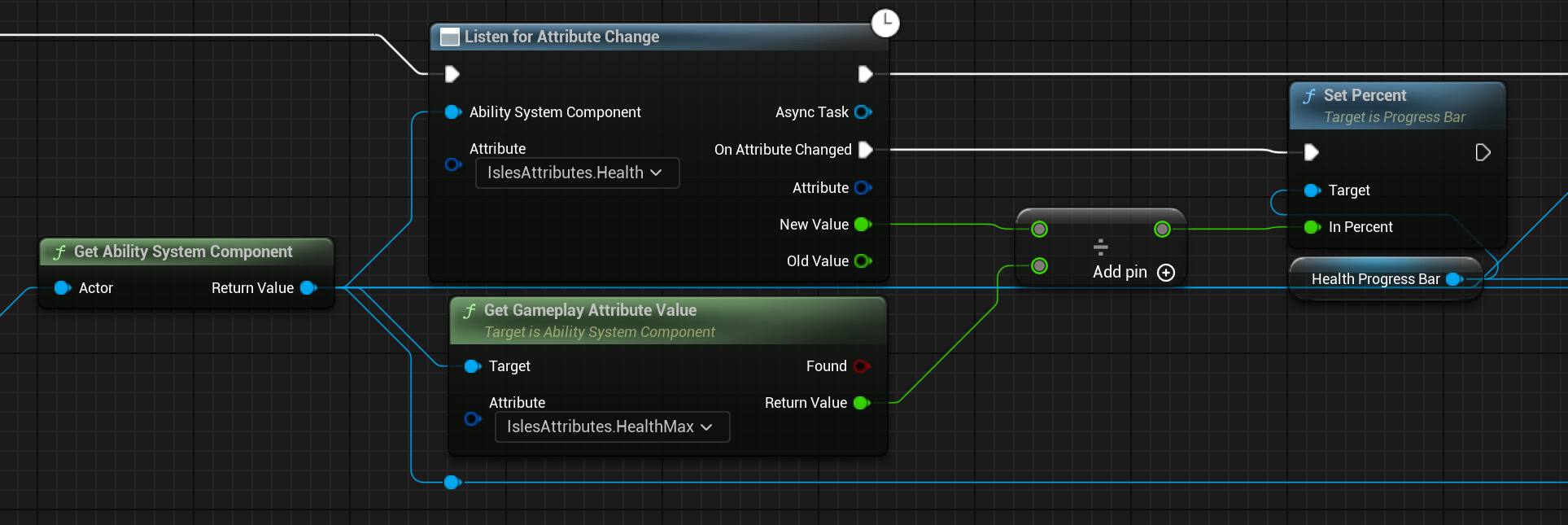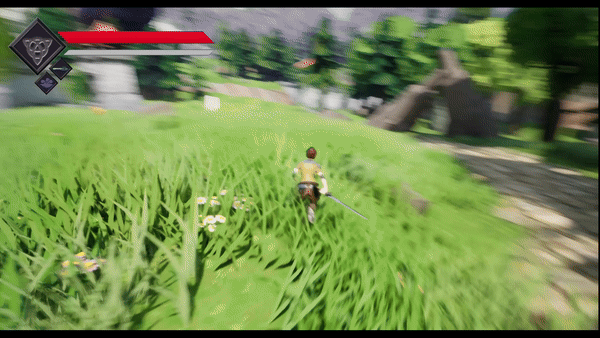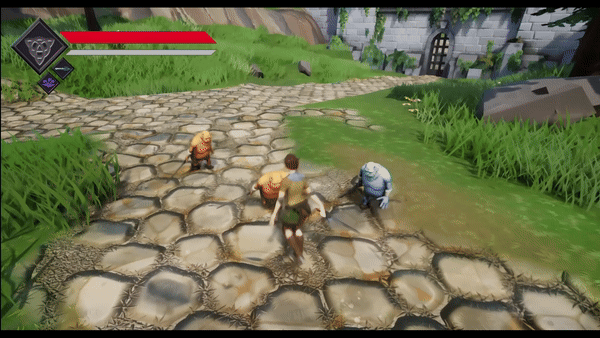Project Description
From the spring semester of my junior year at Shawnee State up until graduation, I worked alongside an incredibly talented team of classmates to develop our game concept of Isles of Aether. The game was envisioned as an action game inspired by titles such as Ghost of Tsushima, Jedi: Fallen Order, and The Witcher 3. The player character is an adventurer tasked with putting an end to the destruction and chaos caused by vicious monsters that are plaguing the majestic Isles in the sky, and they are provided with both sword and sorcery to get the job done.
Accomplishments
- Assisted with pre-production of the game throughout the spring semester of my junior year and the following summer, helping to choose a direction for the project, design combat mechanics, and prototype the lock-on and magic systems.
- Elected as Technical Director for the project.
- Worked alongside other leads to create production plans, assign tasks, and review work.
- Utilized the GAS plugin to create and iterate on the game's magic system.
- Built an asynchronous GAS attribute listener.
- Implemented a universally applicable cooldown GameplayEffect.
- Programmed the player character's sprinting attack.
- Collaborated with other members of the Combat team to rework and improve the game's combat throughout the senior spring semester.
Objectives and Implementation
GAS Magic System
This being my senior capstone project, I wanted to carve out a game system for myself to work on which would showcase my abilities as a programmer. Over the summer I became acquainted with Unreal's GAS plugin through my work on Chaos Pattern, which struck me as the perfect tool for bringing to life the wide variety of magical abilities we had designed for the game. I spent my free time building a rough prototype to showcase what the plugin could do for us, and convinced our Production Lead to approve my strategy. For the majority of the fall semester, my work on the project consisted of setting up necessary GAS components, building versatile base classes for each major spell type, training others to be able to work with the GAS framework, and addressing bug reports related to the system.
The AoE ability class I created serves as a good example of how creating flexible core classes can significantly speed up content creation in game development. This ActivateAbility event from the class demonstrates the general process by which all AoE abilities in the game function. Following a check to validate that any costs associated with casting the ability can be met, the Cast Spell function is called on our Weapon Manager component to return the AnimMontage that should be used by the casting character when casting this spell. At some point in each spellcast montage, a "CastSpell" notifier is sent. When this notify is fired, the ability proceeds with unleashing the actual spell. An IsTargeted boolean is used as a configuration variable to specify whether the AoE should be placed around the caster or if it should seek other characters to target. Finally, the GameplayEffect to be distributed by the AoE field is configured, and the actor which handles collision and application of this effect is spawned. An asynchronous delay task is created to call EndAbility after the ability's lifetime has run out, cleaning up the field actor and beginning the ability's cooldown.
During pre-production, I identified this basic pattern as one which could be applied to all of our AoE spell designs. Creation of this basic class proved to be very helpful in the production of new abilities. To develop a new AoE spell for the project, all that was needed was the creation of unique sound and visual effects as well as the GameplayEffect to be applied. Three different programmers were each tasked with producing three spells, each of which inherit from one of the core classes I developed (AoE, Projectile, and Buff). Even with handling implementation of temporary SFX and VFX themselves, and being thrust into having to learn the sparsely documented GAS plugin, my teammates were all able to complete their tasks in no more than two weeks of work, which speaks to both their own skill and the versatility of this core system.

In my work on the magic system, I also implemented two incredibly useful features: an asynchronous attribute listener object, and a universally applicable cooldown GameplayEffect. The AsynAttributeListener is a blueprint node which can be configured to listen for changes in one or more GameplayAttributes. This node is basically a wrapper around the GameplayAttributeValueChanged delegate on the Ability System Component and offers a quick and simple way to set up events that need to occur whenever a particular attribute is modified. It is being used in our game's UI to update health and stagger bars for all of our characters.

The universal cooldown implementation was mostly referenced from tranek's incredibly helpful GASDocumentation page, and I highly recommend it as a neat and tidy solution to the need for gameplay effects when applying ability cooldowns. In our project, I was able to implement universal cooldown by adding CooldownDuration and CooldownTag variables to the game's base ability class. When an ability's cooldown is committed, it dynamically adds its own unique cooldown tag to our singular cooldown GameplayEffect. This effect then uses a custom modifier magnitude calculation to reference the ability's CooldownDuration and set its own duration to match. By implementing this solution, we saved on the need to create unique GameplayEffect classes for each ability's cooldown, cutting the work required down to simply creating a unique GameplayTag.
Sprint Attack

After receiving feedback on the project from the Shawnee Game Conference in November, we realized the immediate need for more momentum and movement in our game's combat, which at the time was fairly stiff and wooden. I suggested that we borrow the mechanic of a sprinting attack from other action games as a way to hasten the player's entry into combat situations and give them an exciting opener attack. I took responsibility for implementing this feature, hoping to learn more about Unreal's animation features and the process of implementing an attack in a 3D action game, a task which I had never taken on in the past.
I faced numerous challenges in implementing this feature, first of which was the acquisition and importation of a suitable temp animation. Luckily, I was able to quickly find a free-to-use attack animation from Mixamo that suited our purposes, but after testing I discovered that the animation's movement was far too slow to fit into the more fast-paced flow of our game's combat. Additionally, the player would always move the same distance for each jump, even though a shorter jump would be expected when attacking a closer enemy. To fix these issues I disabled root motion on the animation and programmed the motion of the attack manually. This was handled by using the Suggest Projectile Velocity Custom Arc and Launch Character functions provided by Unreal. To address the speed of the animation, I ended up splitting the full animation into two separate Animation Sequences, one for the jump segment and one for the recovery segment. These two segments are put back together in the final Montage and both are sped up, but the recovery segment required a faster play rate than the jump. Additionally, to improve the attack's feel in combat, I added code to have the attack "snap" to a nearby enemy if they are in the attack path. This eliminates the possibility of missing an attack just because the angle you attacked at was off by just a degree, and combined with the custom arc for the jump, creates an expected visual of the character landing just in front of the enemy they intended to strike.
Combat System

Post-SGC, our team undertook a major effort to rethink and overhaul our game's combat. We went back to the games that inspired us and took in-depth notes on their combat mechanics. After analyzing each game, we identified that the primary elements we needed to develop were the addition of momentum with each attack and natural-looking reactions to attack impacts to improve the flow of combat and the satisfaction from engaging with it. The first change implemented to address these was the sprint attack I developed, but while I was working on that, my teammate Justin Meyer was working on a prototype version of the overhauled system. Midway through our final semester working on this project, Justin completed his prototype and our team was heavily in favor of implementing the changes that were made. From that point on, the focus of my work on the project involved working alongside Justin to integrate these changes into Isles, which involved translating a lot of that work from Blueprint code into C++ code.

The core of the rework was Unreal's Motion Warping plugin. The features provided by the plugin allowed us to easily add smooth movements with each attack animation, allowing the player to close gaps and providing a sense of forward momentum. A MoveTarget component was added to the player character to modify the location for an attack's motion warp. While the player is idle, the target will remain in the character's forward direction, but while the player is moving, they can manipulate their attack direction by moving the mouse or right analog stick. The distance of this target from the player is determined by an "AttackForce" variable tied to each animation, allowing us to tweak just how far a certain attack will carry the player. With these changes, we were now able to give the player the feeling of being able to jump between engagements with enemies on all sides, and (with knockback features implemented by another teammate) press enemies backward.
Reflection
With an entire year's worth of development, there is a great deal to reflect on with Isles of Aether. Here are what I feel are the biggest takeaways I have from the entire experience.
- Leadership is necessary and important to establish early. For our entire design phase of the game, we had no leadership aside from our designated Production Lead. As a result, our game was designed by committee and could never adhere to a singular guiding vision. This resulted in mechanics that did not mesh well together, no real narrative direction, and increased difficulty in resolving disagreement. For me, the lesson learned is to design a game, you need a pitch, and to make that game, you need a Creative Director that understands the design inside out and can make changes or additions that all make sense within the game's design philosophies. At the very end of that semester, we held our very last vote to designate our different lead roles and hand people the authority needed to make decisions for the project as a whole, but I think that the end product was unfortunately limited by the lack of a true vision for what it should be. That being said, I believe that our artists and composer did amazing work to add character and expressiveness to the little world and story design we were able to offer, and their talents do clearly shine in our project.
- Get feedback early and often. This is standard game development advice that I've heard several times before, but our work on this project made the sentiment felt and demonstrated why it is important. By the time SGC was coming around, a lot of the core mechanics had been implemented in the game, and we (leadership) were beginning to struggle with providing our engineers with new tasks. Receiving feedback at SGC showed us the key areas that we truly needed to focus on and exposed the features that were the most lacking in polish. This resulted in a pivot away from building out our magic system to add all of the abilities we wanted players to acquire throughout the game toward our reworking of combat and a renewed focus on the intelligence of our enemy AI. In my opinion, this was a major course correction which significantly improved the quality of our product.
- Learn as much as you can from the other members on your team. After developing the magic system, I had to find something new to do, and that turned out to be working on improvements to the game's melee combat feel. Along the way, I ended up delving quite a bit into Unreal's animation features and animation in general to learn what makes attack animations feel good and what I can do to tweak an animation in that direction. Justin, our resident animator, was able to show me a lot that I didn't know about the animation process and how animations work in Unreal. Before working on implementing the sprint attack, I did not know what the difference was between Animation Sequences and Montages, what AnimNotifiers were, or how Animation Blueprints work. Now that I've worked with all of these and understand them to a moderate extent, I can be a much more effective member of any Unreal team. I think that as a game developer, it is important to at least have basic knowledge about all the tools your engine provides, and talking to a teammate who specializes in the area you need to know more about is probably the best way to learn quickly.
Our year of development was not without major setbacks and misfortune (our month without Perforce and the cancellation of ECGC 2024 come to mind), and I am without a doubt proud of the work that myself and my team were able to accomplish through it all. Though the scope of our final product is quite small, I think that the level of polish we were able to give to this little piece of a game is incredible given that we were all juggling the most difficult classes of our college careers, and for some of us, an actual career on top of that. While there are no plans to develop this game further post-graduation, all of us highly enjoyed getting to know and work with each other over the past year, and a majority of our team intends to continue working on new projects together. Whether that be as a part time hobby or a true business venture, I believe that a lot of us have become lifelong friends and collaborators, which might just be more valuable than all of the programming knowledge I gained from this.